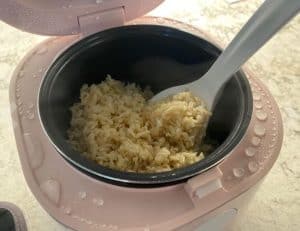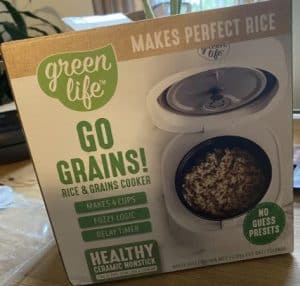I’ve always loved cooking. I love watching the transformation of ingredients into a beautiful, delicious, and nourishing dish. Todays topic; what size rice cooker for family of 4?
I’m sure I inherited my love for food from my mother, an amazing cook. She taught me how to make rice in our family’s ceramic rice cooker when she first got married; it was one of her most treasured possessions because it had been passed down through generations in her family. But eventually, over time, the pot lost its shine and became scratched with use, so we decided to buy a new ceramic rice cooker for our own home–and now I can pass this tradition on to my children too!
So, what size ceramic rice cooker should I buy for a family of four? Keep reading, and we will talk more about ceramic rice cookers and how to find the perfect one for your family’s needs.
What Size Ceramic Rice Cooker Should I Buy?
To determine the size of ceramic rice cooker you require, consider how many people will be eating and how often you cook rice.
 If you purchase a small one, it won’t yield enough for everyone to eat at once; however, if you get a larger one, there is the risk of storing too much-cooked rice in the pot, and it will become overcooked and mushy over time.
If you purchase a small one, it won’t yield enough for everyone to eat at once; however, if you get a larger one, there is the risk of storing too much-cooked rice in the pot, and it will become overcooked and mushy over time.
It’s a good idea to determine the size of ceramic rice cooker you need by considering how often you eat white, brown, or porridge-style rice, as well as other staple dishes such as soup or stews. If you have a family of four, I recommend purchasing a 5-liter ceramic rice cooker.
What to Know About Ceramic Rice Cookers
Ceramic rice cookers are convenient and helpful because you can use them for multiple things other than simply cooking rice. Because of this, it’s often the preferred cooker among the Japanese community. You can use these types of cookers to make traditional Japanese dishes such as sticky rice (mochi) or even steam fish, to name a few.
Most cookers will have two settings: “warming” and “keep warm,” which lasts about 12 hours. Generally, the keep-warm setting is good enough, but if you’re planning to use your cooker for mochi or something that’s not recommended to be left on for extended periods, then the “warming” setting might be better.
 Rice cookers typically have three heat settings: less heat (level 1), medium heat (level 2), and high heat (level 3). You can use the “less heat” setting for softer foods such as vegetables, and you can use the “high heat” setting to fry ground beef quickly. Remember that some food will cause more sticking than others, so try adding a little more water or adjusting the heat level if there is excessive sticking.
Rice cookers typically have three heat settings: less heat (level 1), medium heat (level 2), and high heat (level 3). You can use the “less heat” setting for softer foods such as vegetables, and you can use the “high heat” setting to fry ground beef quickly. Remember that some food will cause more sticking than others, so try adding a little more water or adjusting the heat level if there is excessive sticking.
To clean your cooker after using it, just rinse with water and wipe clean using a sponge or rag. For tougher stains, try soaking a rag in a vinegar solution for about 10 minutes, and then clean as you usually would with your cooker.
How to Buy a Ceramic Rice Cooker
There are many brands and types of ceramic rice cookers, but they can be classified into three categories: stainless steel-based pot, aluminum-based pot, and cast iron-based pot. Let’s take a closer look at what each type means:
- Stainless steel-based cookers have a shiny mirror finish outside the pot. Typically on the bottom of the pan, there will be a thin line of metal that you can check for its authenticity.
- Aluminum-based cookers are lighter but still provide good durability and heat distribution. The outside of this type of cooker is typically duller than stainless steel-based ones so that it won’t reflect light as much.
- Cast iron-based cookers are heavier than the other options, but they retain heat better and can last longer through many uses. They also help improve indoor air quality by absorbing toxins like lead, mercury, and cadmium.
When it comes time to buy a ceramic rice cooker, there are many factors you need to consider. The size of the pot, how often you cook rice, and what other foods you might want to cook in it are all important things to think about.
We’ve given you some tips on what size rice cooker for family of 4, as well as some general information about ceramic rice cookers. Keep in mind that each type of cooker has its benefits and drawbacks, so choose the best suits your needs. Thanks for reading!
